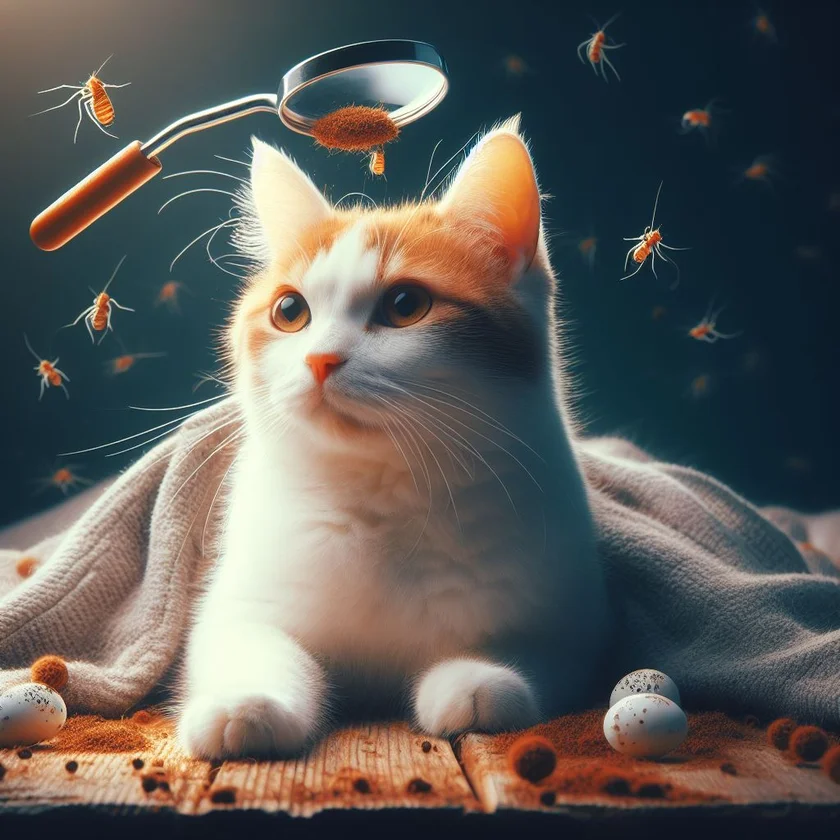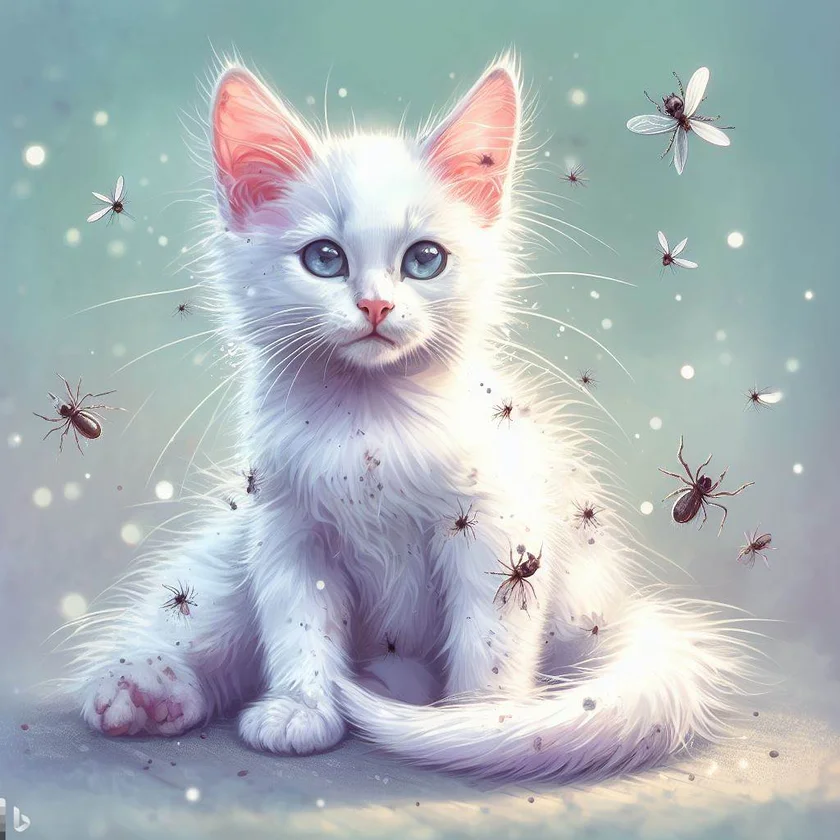
Recognize the signs of infection from cat fleas
Recognizing the signs of a flea infestation in cats is crucial for timely intervention and effective treatment. Here are some common indicators to watch for:
1. Excessive Scratching and Biting
If you notice your cat excessively scratching, biting, or licking certain areas of their body, particularly around the neck, back, and base of the tail, it could be a sign of flea bites. The irritation caused by flea bites often leads to intense itching and discomfort for the cat.
2. Visible Fleas or Flea Dirt
Check your cat's fur for the presence of fleas or flea dirt, which resembles small black specks. Flea dirt is essentially flea excrement composed of digested blood and appears as tiny black dots, often found in the cat's coat or on their bedding.
3. Skin Irritation and Redness
Flea bites can cause skin irritation, redness, and inflammation, leading to the development of small bumps or scabs on the skin. If you notice any signs of skin irritation or notice your cat excessively grooming specific areas, it could be indicative of a flea infestation.
4. Hair Loss
In severe cases of flea infestations, cats may experience hair loss, particularly in areas where they frequently scratch or have flea bite. Patches of thinning fur or bald spots may be visible, suggesting an underlying flea problem.
5. Restlessness and Irritability
Cats infested with fleas may exhibit signs of restlessness, irritability, and a change in behavior. They may become more agitated, restless, and feral cats may even display signs of anxiety due to the discomfort caused by the fleas.
6. Flea Allergy Dermatitis
Certain cats may develop an allergic reaction to flea saliva, leading to a condition known as flea allergy dermatitis (FAD). Symptoms of FAD include severe itching, hair loss, and inflamed skin, often resulting in secondary bacterial infections.
Promptly identifying these signs of flea infection in cats is crucial for initiating the appropriate flea treatment and preventing further discomfort and health complications.

Know where to look for adult fleas and flea eggs
When dealing with a serious flea infestation or aiming to prevent a future infestation or flea problems, it is crucial to know where to look for adult fleas and flea eggs. Conducting a thorough inspection of specific areas in and around the house can significantly aid in effective flea control.
1. Pet Bedding and Resting Areas
Start by inspecting your pet's bedding, as well as any other areas where they frequently rest or sleep. Fleas and their eggs often accumulate in these warm and cozy spots, making them prime locations for infestations.
2. Carpets and Rugs
Flea eggs and larvae of fleas tend also to hide within the fibers of carpets and rugs. Vacuuming these areas regularly, especially in corners and along baseboards, can help remove both adult fleas and their eggs, significantly reducing the risk of future infestations.
3. Upholstered Furniture
Check upholstered furniture, such as couches and armchairs, as these areas can harbor adult fleas and their eggs. Use specialized flea control products, like sprays or powders, designed for furniture to eliminate any existing infestation and prevent its recurrence.
4. Cracks and Crevices
Inspect cracks and crevices in floors and walls, as these tight spaces can serve as hiding spots for adult fleas and their eggs. Employing targeted treatments, such as insecticidal sprays or diatomaceous earth, can help eradicate fleas from these hard-to-reach areas.
5. Outdoor Areas
If your pet spends time outdoors, inspect their favorite resting spots, such as shaded areas and outdoor furniture. Implementing outdoor flea control measures, like treating the yard with flea-repellent products or keeping grass and shrubbery trimmed, can help minimize the risk of flea infestations.
By diligently examining these key areas for adult fleas, flea larvae, and flea eggs, and by implementing appropriate flea control measures, pet owners can effectively manage current and future flea infestations and prevent the recurrence of flea-related issues in the future. Regular communication with a veterinarian can provide valuable guidance on maintaining a comprehensive flea control regimen suitable for the specific needs of your pet and household.

Best Flea Treatment for Outdoor Cats: How to Protect Your Feline Friends
Fleas can be a pesky nuisance for any pet parent, causing discomfort and potential health problems for their beloved feline companions. To ensure the well-being of cats, it's imperative to implement effective flea treatments, incorporating a combination of topical solutions and thorough cleaning methods.
When it comes to flea treatments for cats, topical solutions have proven to be one of the most efficient and convenient options. Products like vet-recommended spot-on treatments, containing ingredients such as fipronil or imidacloprid, are highly effective in eliminating fleas and preventing their resurgence. These solutions are easy to apply, usually directly on the skin at the base of the cat's neck, making them a preferred choice for many pet owners.
However, it's important to recognize that the battle against fleas doesn't solely rely on the application of topical treatments. Comprehensive cleanliness measures are equally crucial.
Thoroughly vacuuming the house, especially areas where the cat frequents, can help remove flea eggs and larvae from the environment. Washing the cat's bedding in hot water and using a pet-safe flea spray for furniture can also aid in preventing re-infestation female flea.
For a comprehensive approach, pet parents should also consider their cat's overall health during flea treatment. Some cats may have existing health problems, such as sensitive skin or allergies, which could be aggravated by the chemicals in certain flea treatments. Consulting a veterinarian before starting any treatment regimen is advisable to ensure that the solution is suitable for the cat's specific health needs.
In conclusion, the best flea treatments for cats incorporate a multi-faceted approach, including the use of topical solutions, thorough cleaning practices, and consideration for all the fleas and cat's individual health requirements. By combining these strategies, pet parents can effectively tackle flea infestations and ensure the well-being and comfort of their feline companions.

DIY Home Remedies
While professional veterinary care and commercial products are typically the most effective solutions for eliminating fleas, there are some DIY home remedies that can offer temporary relief for cats. Here are a few natural options to consider:
1. Apple Cider Vinegar
A diluted solution of apple cider vinegar can be used as a spray to repel fleas. Mix equal parts of raw, unfiltered apple cider vinegar and water, and lightly spray it on your cat's fur, avoiding the eyes and any open wounds.
2. Diatomaceous Earth
Food-grade diatomaceous earth is a natural, powdery substance that can be sprinkled on carpets, furniture, and pet bedding. It works by dehydrating and killing fleas and their larvae. Ensure that the product is food-grade and follow the instructions carefully to prevent any respiratory issues for your cat.
3. Lemon Spray
Boil a sliced lemon in water and let it steep overnight. Transfer the solution to a spray bottle and apply it to your cat's fur, avoiding the eyes. The natural acidity in lemons can act as a repellent for fleas.
4. Rosemary Infusion
Create a rosemary infusion by boiling fresh rosemary leaves in water. After cooling, pour the solution into a spray bottle and use it on your cat's coat, avoiding the eyes. Rosemary is believed to have flea-repellent properties.
5. Flea Comb and Soapy Water
Regularly comb your cat with a fine-toothed flea comb and have a bowl of soapy water nearby. After combing, dip the comb into the soapy water to drown and get rid of any fleas that have been caught.
It's important to note that these DIY remedies may not be as effective as professional treatments, especially in severe infestations. Additionally, some cats may be sensitive to certain ingredients, so it's essential to monitor your cat for any adverse reactions. If the infestation persists or worsens, it's crucial to seek professional veterinary advice for a more comprehensive and long-term solution.

What Is The Best Flea Protection Method?
The best flea protection method for cats involves a comprehensive approach that effectively targets fleas at various stages of their lifecycle. For cat owners seeking an efficient solution, a combination of flea treatments is recommended. Firstly, using topical spot-on treatments that kill fleas and prevent their re-infestation is essential. These treatments are often prescribed by veterinarians and can be easily applied to the cat's skin, providing long-lasting protection.
In addition to spot-on treatments, using a flea collar can be a valuable preventive measure. These collars release active ingredients that repel and kill fleas, providing continuous flea free and protection for several months. However, it's crucial to choose collars that are specifically designed for cats to avoid any adverse reactions or discomfort.
For more immediate relief, occasional use of flea shampoos can effectively eliminate adult fleas on the cat's coat. These shampoos often contain insecticidal ingredients that target and eradicate fleas upon contact. However, caution must be exercised to ensure that the flea shampoo used is suitable for feline use and doesn't cause any skin irritations.

Implementing a tick spray, especially in environments where ticks are prevalent, is a prudent measure. Tick sprays formulated for cats can effectively repel and kill ticks, reducing the risk of tick-borne diseases and ensuring the cat's overall well-being.
Maintaining a clean indoor cat environment plays a crucial role in combating flea infestations. Regular vacuuming, especially in areas where the cat spends time, can eliminate flea eggs, larvae, and pupae from the environment, thus preventing re-infestation. Emptying the vacuum cleaner immediately after each use is imperative to prevent fleas from re-infesting the house.
By incorporating these diverse, flea prevention and protection methods, cat owners can effectively safeguard their feline companions from the discomfort and health risks associated with flea infestations. Regular communication with a veterinarian can provide tailored guidance and ensure the best protection strategy for each individual cat's needs.




